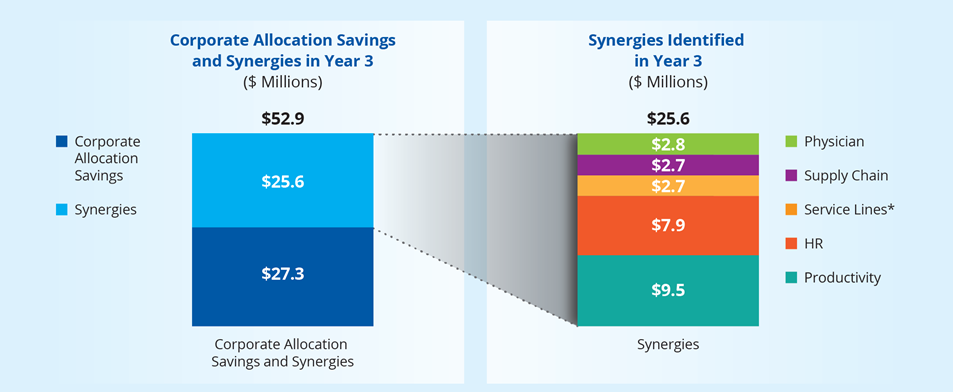How health systems can avoid unforeseen obstacles during a merger

Careful, intentional integration planning helps merging parties achieve the promise of the new organization.
As hospitals and health systems focus on transforming and improving how they deliver care to their patients and communities, an increasingly attractive option for them is to merge with a counterpart organization and create a combined entity better positioned to achieve those goals. In the third quarter of 2020, Kaufman Hall research identified 19 announced mergers, suggesting that the ongoing COVID-19 pandemic may be strengthening the rationale for new, transformation-focused activity.
This approach requires careful, intentional integration planning. Without it, merging parties may face a host of unexpected barriers that can undercut the new organization’s promise. Ideally, integration planning starts with the development of a strong business case and continues through the pre-close transition and the onset of the new organization’s combined operation.
Developing the business case
As they begin to develop the business case for the transactions, the parties also should ensure financial planning is an integral element in the strategic rationale for the partnership. They also should create a common vision for how the new organization will operate and achieve its goals.
An important first step in building the business case is to define how success for the merger will be measured and document the benefits that staff, patients and communities will receive. During this phase, the parties should:
- Identify operational synergies
- Develop a potential enterprise operating model
- Perform a strategic assessment of the rationale for the combination
The organizations also should begin to develop financial models highlighting the value created from bringing the parties together. Ultimately, the purpose of financial planning during the development of the business case should be to inform leadership and board-level decisions regarding the question of whether to move forward with a letter of intent (LOI).
Planning the transition
After the LOI is completed, merging entities should proceed with planning within a transition process focused on refining synergies, developing functional operating models and identifying a unified approach and guiding principles for the future organization.
At this stage, parties should prepare to launch teams with leaders from both organizations for a comprehensive set of functions — from physician alignment to IT to human resources, just to name a few. They also should begin to develop the governance to guide the partnership. Establishing an integration management office (IMO) can help the organizations centralize management of all activities.
An IMO’s purpose is to manage core functions of activity, including the following:
- Culture, change management and communications
- Baseline definitions, analytics, synergies, reporting and monitoring
- Project management and process design
- First-day transition and post-close integration planning
Organizations also should develop transition and integration roadmaps, which can help design, drive and monitor activities of both day-one plans as well as operational integration.
Managing execution
Day one of the new organization traditionally marks the moment when the merged organization gains full visibility into operational and financial details that were previously limited or restricted to a black-box analysis due to antitrust regulations. The organization should now be prepared to begin functioning as a single entity focused on executing the operational model and realizing the benefits of the merger. Typically, this phase lasts one to two years before normal operations commence.
During this stage, organizations should conduct comprehensive analyses to identify, validate, implement and track synergies and refine operating models and reporting relationships based on combined organizational data. Organizations should begin to implement the integration roadmap to form the new leadership and reporting structures, optimize operating models and deliver care as a single organization.
Communication and change management efforts also should be fully implemented with full support of the combined organization’s leadership team. These efforts should include creating a system for reporting progress to the executive team or a related steering committee.
Merger integration during a pandemic: The Virtua Health-Lourdes story
In July 2019, Virtua Health, a three-hospital system in New Jersey, formally acquired Lourdes Health System, a nearby two-hospital system, with the intent of creating a “New Virtua” informed by the best of both organizations and focused on high-quality, safe patient care.
“There was a high degree of expectation from the CEO, our executive leadership team and the board,” said Stephanie Fendrick, senior vice president and chief strategy officer for Virtua Health. “They really supported the team in what needed to be accomplished and how quickly we needed to move.”
During the transition phase, Virtua leaders identified potential targets and areas of focus for building a stronger care delivery model, including leveraging Lourdes’ tertiary care and advanced clinical services. After the definitive agreement, Virtua identified and launched more than 300 specific integration initiatives to help realize more than $25 million (results have been blinded for confidentiality purposes, but represent actual performance) in synergies by year three of the new organization.
Virtua Health’s set synergy targets*

*Note: The figures shown here are representative of actual results that have been blinded for confidentiality purposes.
Source: Courtesy of Virtua Health
In March 2020, eight months after the combined organization began operations, New Jersey was hit hard by the first wave of the COVID-19 pandemic in the Northeast. Although Virtua was forced to put many of its integration plans on hold from March to May to focus on providing care to patients impacted by the pandemic, the existing integration efforts were ultimately accelerated. For instance, Virtua moved ahead with efforts to optimize care, with a focus on identifying duplicative services and evaluating consumer care preferences in specific markets.
“We looked to achieve a balance,” said Ruoran Zhang, Virtua’s director of integration. “Some service lines may be appropriate to consolidate, but for others, a more distributed model is better. Considering community needs is very important for a nonprofit.”
Some long-planned consolidation efforts happened organically, including the closure of some physician offices during the pandemic that were never reopened. Virtua also used the list of cost reduction targets from the merger integration to help inform its response to the financial impact of the pandemic.
“We condensed to a three-year integration effort instead of five,” said Michael Capriotti, Virtua’s vice president of integration. “We were very lucky that we had attacked our integration initiatives so aggressively before the pandemic.”
Ultimately, the integration planning exercise allowed Virtua officials to help mitigate the full financial impact of the pandemic.
Prior planning helped mitigate COVID-19’s impact on Virtua Health*

*Note: The figures shown here are representative of actual results that have been blinded for confidentiality purposes.
Source: Courtesy of Virtua Health
5 principles for successful merger integration
Virtua Health’s experiences, and those of other successfully merged organizations, point to five actions that represent key success factors.
1. Integrate financial planning at the outset. All too often, merging entities approach the transaction from a primarily legal perspective. An integrated approach that engages financial planning and forecasting early on can ensure that potential synergies and insights about future operations are included in the details of the transaction to be realized moving forward.
2. Empower integration teams. Prior to close, integration teams should be preparing every facet of operations for successful execution as a combined entity, from nursing to IT to human resources.
3. Create a unified culture. Identifying and assessing the specific challenges of bringing together two organizations accustomed to their own practices is a critical step in creating a unified culture for the new company.
4. Communicate often with staff. Achieving synergies, combining cultures and realizing the goals of a new organization can happen only if leaders and staff communicate consistently with each other throughout the transition and integration processes.
5. Improve how care is delivered. A combined organization can realize its vision of delivering high-quality care only if it focuses on identifying best practices for how care is delivered while also leveraging the strength of each organizations’ existing operations.






